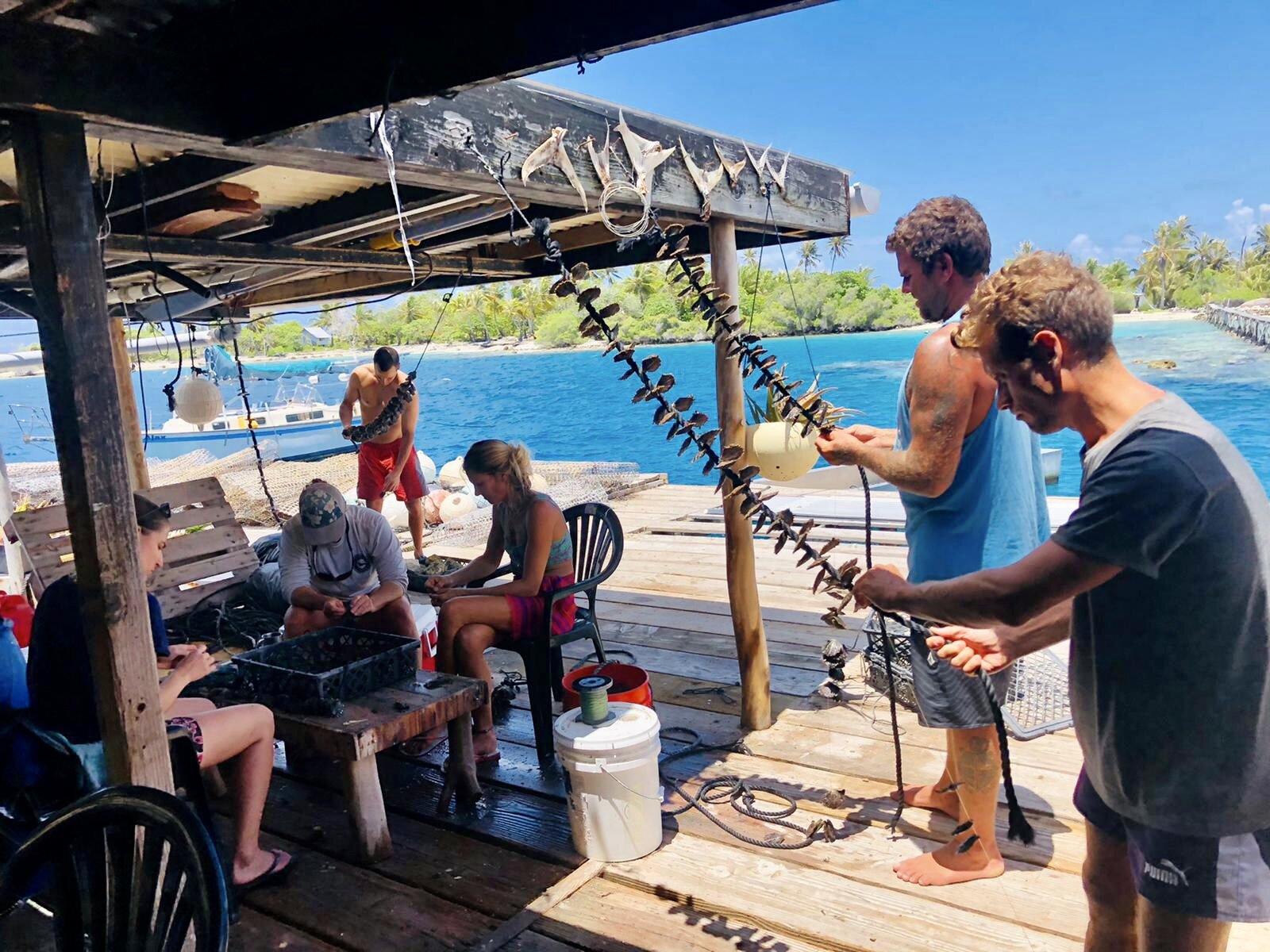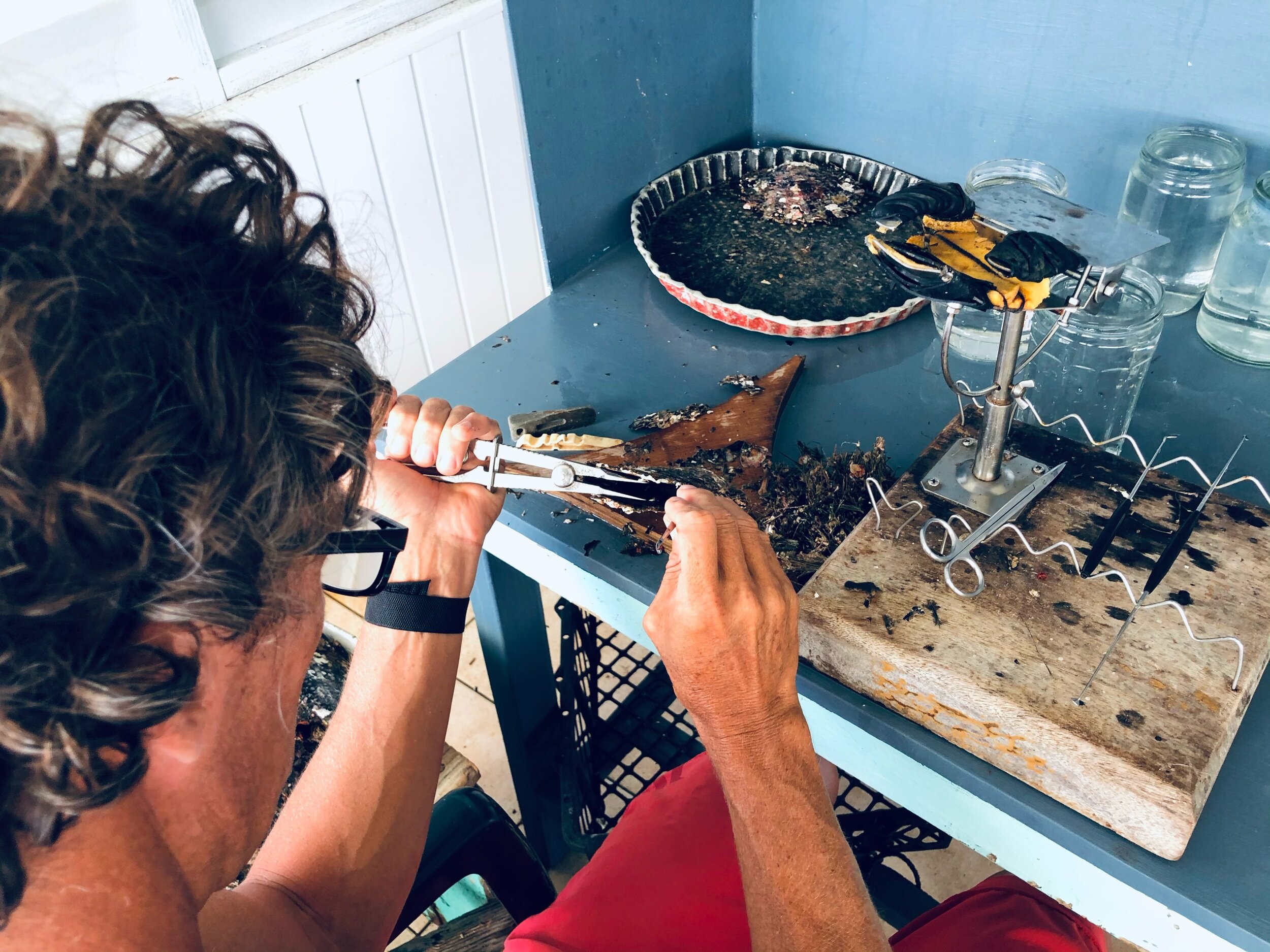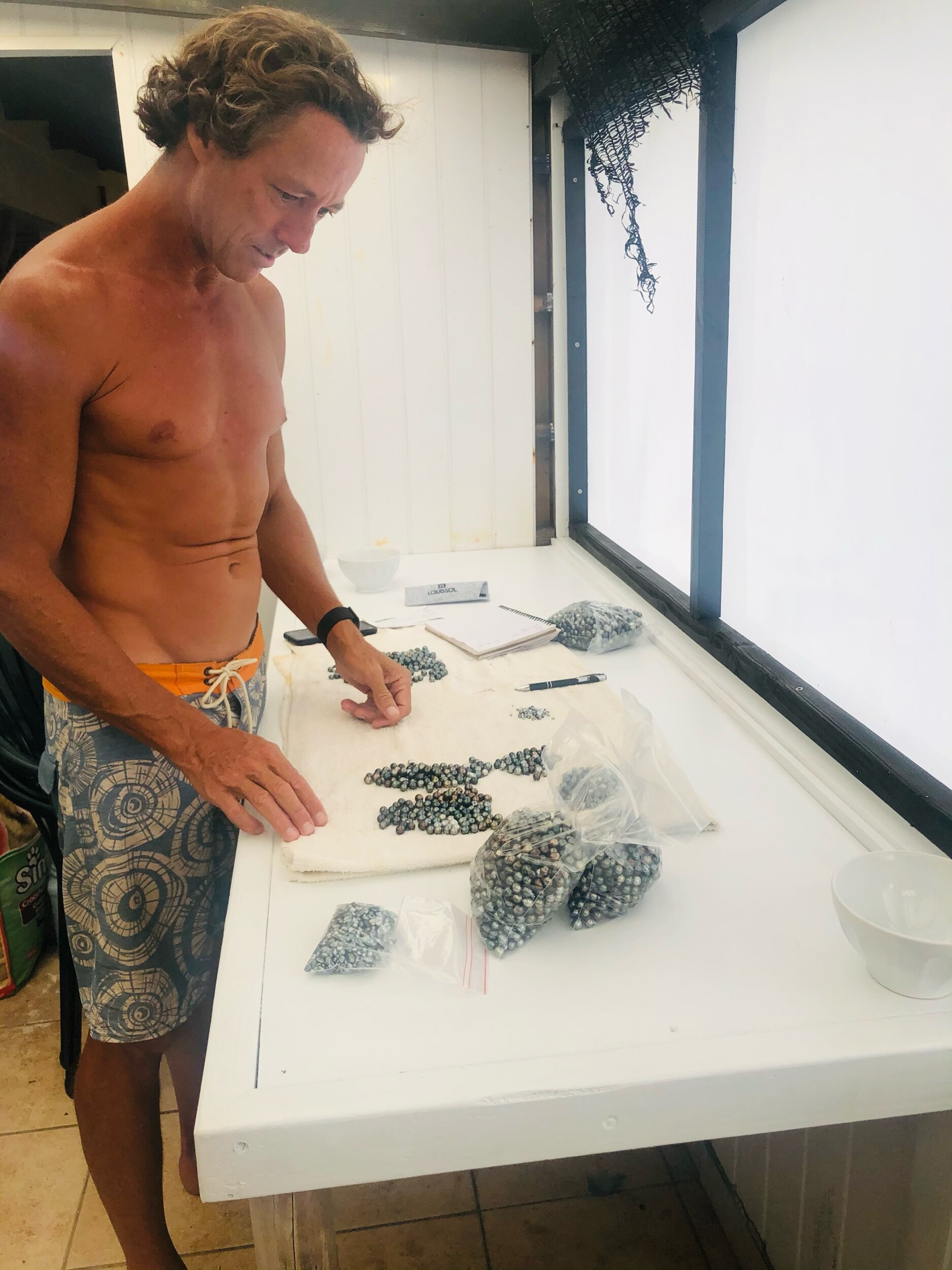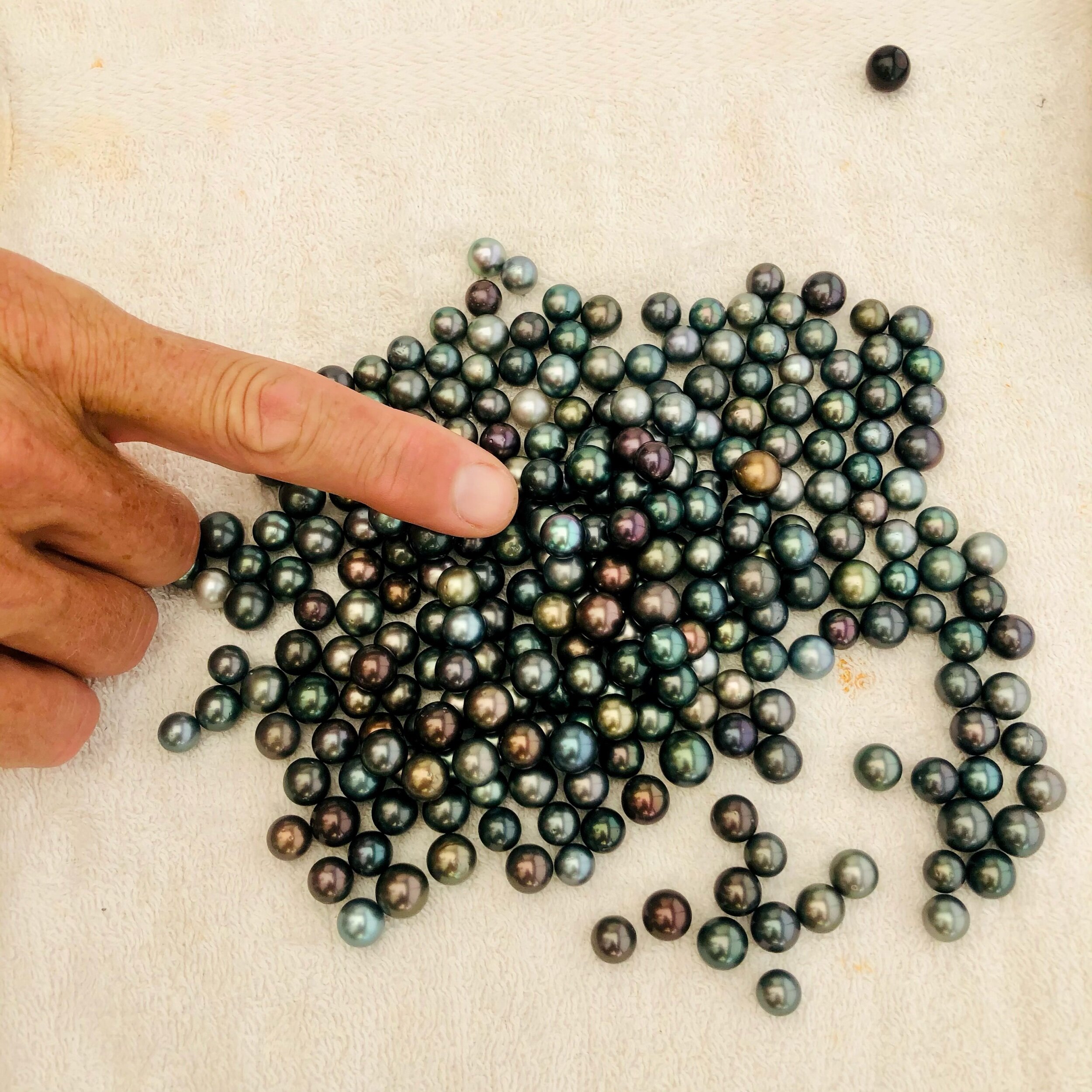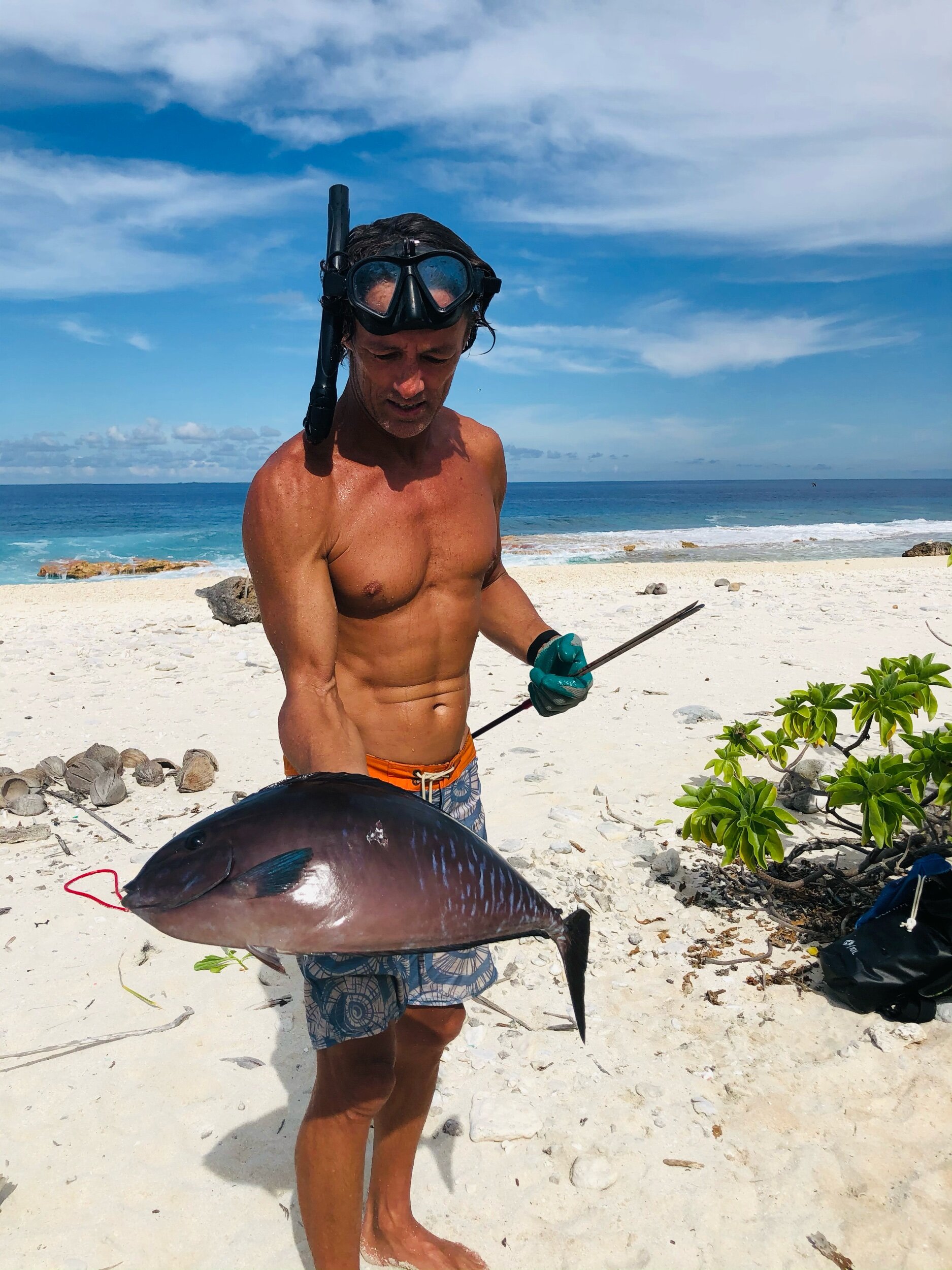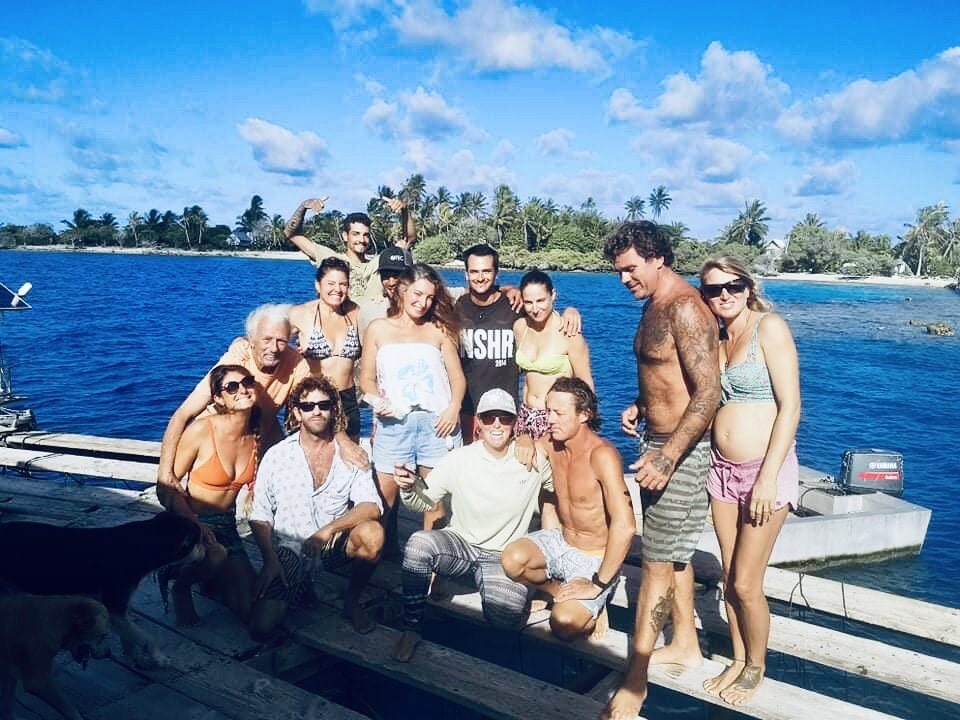Pearls of Wisdom
Regenerative Pearl Farming with Josh Humbert
As we rounded the poito (buoy) I stood up and grabbed the painter. Brian angled us toward a corner of the platform near the ladder and as the crew disembarked, I tied us on to the stilted structure with a bowline. While Kerstin climbed the ladder, I used the stiff rubber tubes of our skiff as a step and hoisted myself up onto the floorboards of the Kamoka Pearl farmhouse. It was a Friday and work was well underway.
In true Polynesian fashion, I greeted each human with the offerings of kisses, salutations and the unavoidable resulting ear-to-ear smile. In return, I was welcomed with the gift of presence, a few moments in time taken from their current task to meet my eyes, exchange sweaty cheek bisous and entertain my makeshift French endearments.
There were roughly a half dozen people buzzing about the farm house on this particular Friday, a number paltry to Kamoka’s operative heyday when over twenty were employed. Regardless of numbers, the tempo was set high. We were nearing the finish line of an arduous two month grafting project.
Josh, an integral source of mana (life force) at Kamoka, was spearheading the seasonal event. With the help of Davy, his work partner and pearl grafting assistant, he was working to finish up a 9,000 oyster harvest.
With 3,000 oysters already back at home on their sub-surface station lines and 3,500 pearls as proof, Josh’s groove at the grafting table was attuned and nearly complete. To commemorate this successful phase of Kamoka’s organic cycle, and to tap into his humble wisdoms while I still had the chance, I sat down with Josh during his final hours of focus.
Interview with Josh Humbert
Co-Owner & Head Pearl Grafting Technician
A: What are you doing right now?
J: Right now I am implanting a shell bead nucleus and a piece of mantle tissue in the body of a host oyster.
A: What do you mean by “host oyster”?
J: A host oyster is an oyster that will carry and birth a pearl.
A: Are there ever naturally occurring pearl births?
J: Yes, there are naturally occurring pearls. And they result a majority of the time from parasites that bore through the shell and get entombed by the oyster. The oyster suffocates the intruder by entombing it within its own flesh. That’s how most wild or natural pearls are formed. But, they are exceedingly rare.
A: And so what you’re doing right now is simulating that natural process?
J: Not really… because I'm not putting anything in the mantle of the oyster. I'm doing a transfer, basically, of shell-secreting cells from one oyster into another. The best analogy is a skin graft. Because the operation is performed in the reproductive organs of the oyster— the gonads of the oyster.
A: Gonads. Roger. And this doesn’t hurt the oyster?
J: It’s a controversial question. Scientists will say no, because an oyster doesn’t have a central nervous system. I feel that our understanding of our world is too limited to say with that much certainty that the oyster doesn’t feel pain. I think that the oyster feels some kind of pain. Maybe not in the way we feel it, but it has its own kind of pain. But, what’s important to understand is that whether it feels pain or not, we tend to our oysters respectfully. And, as a result of the operation, the oyster gets to live a long and prosperous life, as opposed to in the wild where the oyster would most likely get eaten by a fish and perish. So, basically the purpose of pearl farmers everywhere is to bring back the stock of wild oysters. This is important to understand because the truth is that the result of pearl farming is helping the species come back. And that, to me, is very exciting. Because i love oysters.
A: What do you love about them?
J: They seem to have been created to make pearls. This kind of oyster that we are working with in particular (Pinctada margaritifera) has a perfect place to put the nucleus. Their shells are relatively easy to open. This allows us to culture pearls in them. It really seems to me that it's a connection between the pearl farmer and the oyster that has allowed the oyster as a species to flourish. It feels like our fates are intertwined.
A: So, what was the reality or fate of oysters before farming?
J: They were flourishing all over the world but have been decimated for the extraction of wild (natural) pearls and particularly for the harvest of the shell (mother of pearl). They’ve essentially been pushed close to extinction where they were in high numbers before.
A: Can you enlighten us to the role oysters play in the wild? Why they’re important for the ecosystem?
J: They’re the cleaners of the water. They’re filter feeders. So, they run everything through their system, pulling out particulates and purifying the water as they gain access to the plankton that they eat.
A: Do you think the pollution levels of our oceans has contributed to their declining numbers?
J: i think in some places where it’s heavily polluted and everything dies, like industrial harbors, ya, definitely. But, the biggest decimation of wild oysters for uncultured pearls, has come from man.
A: So, what’s the difference between a farmed oyster and a wild oyster?
J: The distinction is really pretty blurry, because the oysters that we’re using come from wild stock. There’s no hatchery here that we’re working with. We gather wild oysters when they’re planktonic (really small) by setting out collectors when the local population spawns. When they’re 21 days old they stop swimming on the current and look for a substrate to affix to. So we’re working with wild oysters. But then, once we take them into our care, I don’t know if you could still call them ‘wild’ at that point, because we look after them and make sure they’re not eaten by predatory fish. The survival rate of wild oysters is infinitely small. So, by protecting them from their main predators, like trigger fish, sea turtles and eagle rays, we’re giving our oysters a chance to live a lifetime of being able to spawn and propagate the species.
A: And how do you look after the oysters, as you say?
J: We put them in baskets to protect them, to keep the predatory fish out.
A: Okay… so then what? What’s the process? Is that even a fair question to ask?
J: Haha. It’s winded. But sure… the oyster is collected at a very young age then grown up to a size in which it can be safely drilled through its hinge without harm to be attached to a string so that we can quantify the oysters and sort them by size. Once we grow the oyster out until it’s about 3 years old, it’s then ready for grafting (seeding). So, ya, more than three years have been invested before it even gets seeded. It’s a long haul. And it requires an immense amount of patience from the farmer. After we seed them (what I'm doing now), then it goes back into the water, into protective baskets. Then it gets meticulously cleaned— that takes the most energy out of every part of the process. Every two months, for about a year, about 18,000 oysters are sequentially pulled out of the deep water stations and brought to shore for cleaning.
A: Is this a standard process in the pearl production industry?
J: It’s not industry standard at all. Hardly anyone does what we do. What we do to clean them is bring them into shallow water platforms where there’s big populations of resident fish. And we let the fish clean the oysters by opening the baskets for a few days. And that’s my greatest source of pride and joy; that the work we are doing has visibly increased the number of fish in our area. So, basically, it takes what we are doing from a status of ‘sustainable’ to ‘regenerative’. And to me, regeneration is the most exciting thing.
After they get cleaned by the fish, then they go back out to the deep water stations, where they can continue growing and feeding on plankton for another two months until getting cleaned again. And then, when they’re about 4 years old, the pearls are ready for harvest.
A: So, there’s fish that eat oysters and fish that clean oysters?
J: Yes. the smaller fish clean the oysters, like parrot fish, surgeon fish, butterfly fish and the likes. That’s just three examples of a vast array of fish that contribute to the cleaning process. Then the titan trigger fish are the predators, the big killers.
A: Okay, thanks for clarifying. And then what happens to the oysters, after the pearls get harvested?
J: The pearl is gently extracted and replaced with another nucleus the same size as the pearl. And the process starts all over again. This can happen up to five times. But, what this means is that the oyster lives a long, healthy life, in which he or she reproduces many times, which ultimately, is the goal of an oyster.
A: What’s the lifespan of your oysters?
J: Ours live longer than oysters in the wild… we think about 30 years!
A: And you said both male and female can reproduce?
J: They are typically hermaphroditic, which means they start out as female and turn male as they get really big. So ya, their sexuality is a little bit complicated. But they can produce pearls throughout this process of transformation no problem.
A: Are there other ways Kamoka is regenerative?
J: Yes. We have self-declared our land and waters as a sanctuary. So it’s a safe zone for every living creature, from fish to coconut crabs to hermit crabs— everything in and out of the water. It’s a safe place for everything to live and flourish.
Do you mind if we go back to fish cleaning?
A: Haha! Yes please!
J: What’s really neat about fish cleaning is the symbiotic relationship with the marine organisms that cause bio-fouling (thousands of different creatures that grow on and in the baskets). There’s a fish species that correlates to every organism that grows on and in baskets. So, by allowing the fish to clean the oysters, you favor all the different kinds of fish. So instead of having one species dominate and push out the others, you have an incredibly democratic way of feeding the fish so there’s something for everybody. The most exciting out of all of those is the parrot fish, which is a steward of the coral. They nibble algae off of dead coral so that new coral can grow once again. So basically, because the parrot fish are our number one cleaners, it correlates to a vibrant coral system around us.
I have goosebumps. I love this.
A: Dude. Mic-drop! Got anything else for us?
J: When we try to do the right thing for the earth and its inhabitants— I don’t want to get too squishy and wooey— but when we try to do the right thing for the environment, the environment thrives and we thrive. The interesting thing to think about is that it comes back to business. It just so happens, that by doing the right thing, it makes dollars and cents. I hate that this came out of my mouth, but it’s true. And I’m grateful that there’s monetary incentive to do the right thing. This isn’t all just charity. It also makes sense. Because the result of all our hard work is beautiful pearls. And pearls are valuable. When we allow our oysters and our lagoon ecosystem to prosper, we prosper too.
Just a few days later, Josh and his wife, Celeste, boarded the weekly prop flight from Ahe to Tahiti. While they’ve both lived at Kamoka for long periods, and still consider it “home”, they now split their time between Ahe, Tahiti and Portland, Oregon.
After their departure, the energy at Kamoka waned to a restful tempo. Work still carried on, however not nearly at the speed or with quite the verve as the past two months. Bisous and salutations were still exchanged. Respect and reverence were still anchored as a way of life. It was just a changing of the tides, a new phase in the cycle, a time for passive regeneration as a direct emanation of nature’s rhythmic wisdom.
For a deeper dive (or to purchase a pearl of your own), check out @kamokapearl or https://kamokapearls.com.



